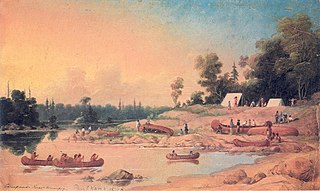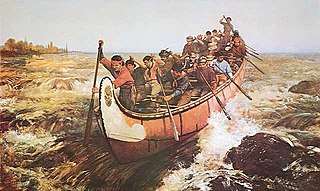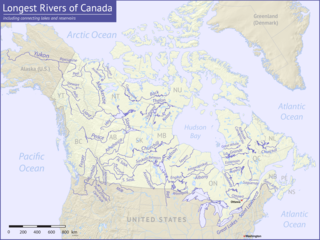
The North West Company was a fur trading business headquartered in Montreal from 1779 to 1821. It competed with increasing success against the Hudson's Bay Company in what is present-day Western Canada and Northwestern Ontario. With great wealth at stake, tensions between the companies increased to the point where several minor armed skirmishes broke out, and the two companies were forced by the British government to merge.
Peter Pond was a soldier with a Connecticut Regiment during the French and Indian War, a fur trader, a founding member of the North West Company and the Beaver Club, an explorer and a cartographer. Though he was born and died in Milford, Connecticut, most of his life was spent in northwestern North America.

The Winnipeg River is a Canadian river that flows roughly northwest from Lake of the Woods in the province of Ontario to Lake Winnipeg in Manitoba. This river is 235 kilometres (146 mi) long from the Norman Dam in Kenora to its mouth at Lake Winnipeg. Its watershed is 106,500 square kilometres (41,100 sq mi) in area, mainly in Canada. About 29,000 square kilometres (11,000 sq mi) of the watershed is in northern Minnesota, United States.

Cumberland House is a community in Census Division No. 18 in northeast Saskatchewan, Canada on the Saskatchewan River. It is the oldest settler community in Saskatchewan and has a population of about 2,000 people. Cumberland House Provincial Park, which provides tours of an 1890s powder house built by the Hudson's Bay Company, is located nearby.

Beaver River is a large river in east-central Alberta and central Saskatchewan, Canada. It flows east through Alberta and Saskatchewan and then turns sharply north to flow into Lac Île-à-la-Crosse on the Churchill River which flows into Hudson Bay.
Isaac Batt was a Canadian fur trader. He was born to parents Dantzick Batt and Sarah Lindsel. He had a younger brother, Dantzick, baptized January 23, 1729. Isaac was baptized January 7, 1731 in Widford, Hertfordshire, England. He was a fur trader mostly with the Hudson’s Bay Company and the first record of him dates to 1754. At that time he had a contract to serve as a labourer at York Factory (Man.).

The Sturgeon-Weir River is a river in east-central Saskatchewan, Canada. It flows about 130 km (81 mi) south-southeast to join the Saskatchewan River at Cumberland House, Saskatchewan. It was on the main voyageur route from eastern Canada northeast to the Mackenzie River basin. The river is a popular wilderness canoe route in Canada.
Joseph La France,, was a Métis fur trader in Canada, and an explorer of the inland route from Montreal to Hudson Bay.

Amisk (Beaver) Lake is a lake in east-central Saskatchewan in Canada. 'Amisk' means beaver in Cree. Saskatchewan Highway 167 provides road access. Denare Beach, the largest settlement, is located on the east side of the lake.

Frog Portage or Portage du Traite was one of the most important portages on the voyageur route from eastern Canada to the Mackenzie River basin. It allowed boatmen to move from the Saskatchewan River basin to the Churchill River basin. The Churchill then led west to the Mackenzie River basin. The fur trade route ran from Cumberland House, Saskatchewan north up the Sturgeon-Weir River. At its source the 300-yard Frog Portage ran, with a 20-foot drop, to Trade Lake on the Churchill a few miles west of the mouth of the Reindeer River. The route then ran at least 250 miles northwest up the Churchill to Methye Portage which led to the Mackenzie basin. For background see Canadian canoe routes (early).

This article covers the water based Canadian canoe routes used by early explorers of Canada with special emphasis on the fur trade.

The voyageurs were 18th and 19th century French Canadians who engaged in the transporting of furs via canoe during the peak of the North American fur trade. The emblematic meaning of the term applies to places and times where transportation of materials was mainly over long distances. The voyageurs were regarded as legendary. They were heroes celebrated in folklore and music. For reasons of promised celebrity status and wealth, this position was coveted.

Revillon Frères was a French fur and luxury goods company, founded in Paris in 1723. Then called la Maison Givelet, it was purchased by Louis-Victor Revillon in 1839 and soon, as Revillon Frères, became the largest fur company in France. Branches were opened in London in 1869 and in New York in 1878. At the end of the 19th century, Revillon had stores in Paris, London, New York City, and Montreal.
Louis Primeau or Primo was one of the first European fur traders on the Churchill River. Primeau Lake in northern Saskatchewan, Canada is named after him. Little is known of his youth. Morton says that he was born in Quebec of an English father and French mother, but the DCB does not repeat this.
Fort Sturgeon (1776–1780) was the first trading post on the North Saskatchewan River. It was located about 4 miles west of Prince Albert, Saskatchewan. It and was also called Peter Pond Fort, Fort Pond, Fort la Prairie, Fort des Prairies, Lower Settlement and Fort Sturgeon River.

Saskatchewan River fur trade The Saskatchewan River was one of the two main axes of Canadian expansion west of Lake Winnipeg. The other and more important one was northwest to the Athabasca Country. For background see Canadian canoe routes (early). The main trade route followed the North Saskatchewan River and Saskatchewan River, which were just south of the forested beaver country. The South Saskatchewan River was a prairie river with few furs.

In fur trade days the term Athabasca Country was used for the fur-producing region around Lake Athabasca. The area was important for two reasons. The cold climate produced some of the densest and thickest beaver fur in North America. The number of furs produced was somewhat greater than its only rival, the Saskatchewan River fur trade. Secondly, the great distance from Montreal and Hudson Bay required the highly developed and efficient transportation system that characterized the Hudson's Bay Company in the nineteenth century.
Fur trading on the Assiniboine River and the general area west of Lake Winnipeg began as early as 1731.
Asleep by the frozen sea is a phrase coined by Joseph Robson to describe the policy of the Hudson's Bay Company (HBC) from its foundation in 1670 until the establishment of its first inland post in 1774. Unlike the French who sent Coureurs des bois inland to trade, the HBC built posts on Hudson Bay and waited for the Indians to bring furs to them. The decision to abandon this policy and move inland gradually turned the HBC into an informal government for western Canada and led ultimately to the confederation of western and eastern Canada.

Lac Île-à-la-Crosse is a lake in North-Central Saskatchewan, Canada on the Churchill River. It is basically Y-shaped. At the center of the Y is the town of Île-à-la-Crosse, the second oldest town in Saskatchewan. The Churchill exits the northeast arm and flows east to Hudson Bay through a series of lakes. The Churchill enters at the northwest arm called Aubichon Arm or Deep River. Upstream it leads northwest to Athabasca Country passing Churchill Lake, Peter Pond Lake, Lac La Loche and on to the Methye Portage leading to Lake Athabasca.












